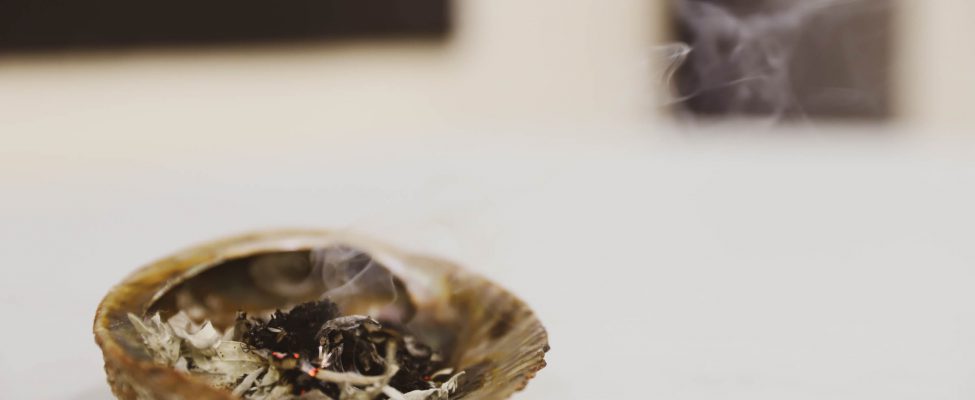Smudging encourages us to stop, slow down, and become mindful of ourselves. When we smudge, we can connect and become grounded. Smudging can help us feel calm and safe and allows us to let go of negative feelings and thoughts.
“Smudging”
The word “smudging,” comes from the English word “smudge,” which means “a blurry spot or streak.” However, the term has been used to refer to the smudging ceremonies of a wide variety of Indigenous peoples, although not all Indigenous peoples refer to the act as smudging. During these ceremonies, sacred herbs and medicines are burned for cleansing.
Here are a couple of words and phrases in Anishinaabemowin to learn that are commonly used when smudging:
- Mashkodewashk – Sage
- Aseema – Tobacco
- Nookwezhigewin – Smudging
- Nookwezige – He/she is smudging medicinally
What is smudging?
Smudging is a tradition common to many Anishinaabe people that involves burning one or more medicines gathered in nature. The most commonly used medicines include sage (mashkodewashk), sweetgrass (wiingashk), and cedar (giizhik). Each medicine will make a different amount of smoke. These medicines are burned in an abalone shell or a vessel (usually copper).
Smudging is always voluntary. It is entirely acceptable for a person to indicate that they do not wish to smudge, and you should never feel forced or pressured to smudge. For many, smudging is a way to start the day right, prepare for a ceremony or meeting, or use it when life gets challenging.
Purpose of smudging
Smudging connects people to the Creator and is a way to gain spiritual protection, receive blessings from the Creator, and improve spiritual health. The smoke created by burning medicines purifies the body, soul and brings clarity to the mind. In this way, smudging is also used to rid any negative energy a person may carry throughout the day. Sacred items and locations can be smudged to clear away negativity. Smudging can be done at any time of day or night, whenever it is needed.
Preparing the smudge bowl
Smudging has been passed down from generation to generation, and there are many ways to perform a smudge. Everyone has their unique way of smudging with their preferred medicines. A common way to smudge throughout the Treaty #3 territory is to place a small pinch of asemaa (tobacco) in an abalone shell or copper vessel. Take a tightly balled-up bundle of dried sage (mashkodewashk), light it from the bottom with a match, and place it on top of the tobacco. A small stream of smoke is all that’s necessary. The smoke from the smudge can be pulled toward oneself with your hands or pushed by another person using a feather or an eagle fan. Whomever lights the smudge should smudge themselves first before bringing the bowl around to others.
Smudging our bodies
The smoke from smudging is similar to the water that we cleanse our bodies with, but instead, it cleanses our spirits. When we smudge, we cover a few key areas: the mind (top of the head), ears, eyes, mouth, heart, back, hair, and whole being (push the smoke down the body towards the floor) and the feet. First, cleanse our hands with the smoke as if we were washing our hands. We then draw the smoke over all of those different areas.
Each area that we smudge carries a different purpose:
- Mind: to have good thoughts
- Eyes: to see the good in others
- Ears: to listen and hear good sounds
- Mouth: to speak well of others
- Heart: to purify our hearts
- Back: to have others watch our back
- Hair: to take care of our lifeline
- Whole being: to portray only the good part of ourselves through our actions
- Feet: to walk a good life
Once the smudge is completed, the smudge ball can burn out naturally. Some choose to bury the ashes or wash them away with water. Check with your local Elders and knowledge keepers about their protocols for the ashes after a smudge.
Interested in smudging on campus?
Seven Generation Education Institute has sage on campus for our staff and students to use, and sage and tobacco in our Fort Frances campus circle room, where our Grandfather Drum and the Grandmother Eagle Staff reside. If you are interested in learning more about smudging, contact our Cultural Lead who is here to guide staff and students through the process of smudging and provide one-on-one cultural mentorship. Learn more about cultural mentorship and other student services at https://www.7generations.org/student-services/#cultural-supports.
